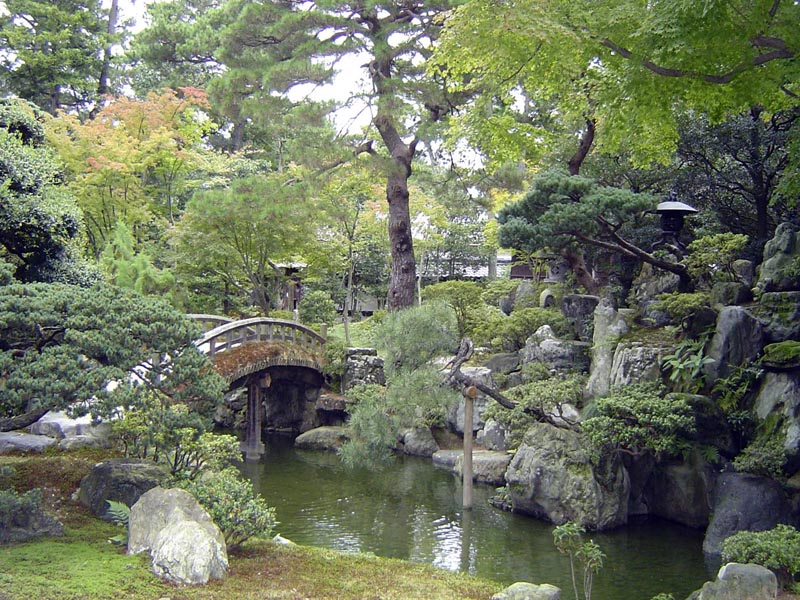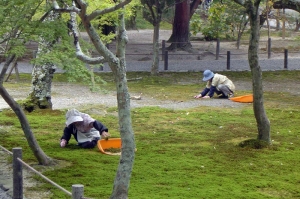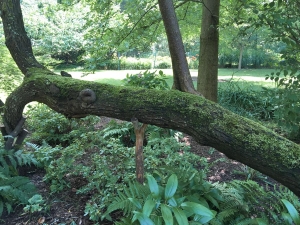Extolling the Lowly Moss
By Gretchen Spencer, Fairfax Master Gardener
Most of us see moss growing in our lawns and wonder how we can get rid of it. My experience as a Master Gardener has taught me that a healthy, vigorous lawn is the best defense against moss and weed encroachment in the turf. And, yes, we do equate moss with weeds. This month, rather than investigating what a healthy lawn requires and how to rid the lawn of unwanted moss, we’re going to extol the virtues of moss and consider giving it a place in the landscape. Next month, we’ll give advice on how to eliminate moss from the turf.
I’ve always admired the soft patches of moss growing in the woods and along tree stumps in shady places. The first time, though, that I saw moss given a place of stature in the garden was on a trip to Japan many years ago. Moss is integral to Japanese garden design and has been for hundreds of years. It lends texture, color and serenity to the garden and combines beautifully with rocks, stone, water and trees. Here are three pictures from that trip. Two of them show beautiful gardens in Kyoto, and the other shows women weeding the moss in a park to maintain its uniformity.
Several articles and books that I consulted extol the virtues of moss as a lawn replacement, a ground cover and an enhancement to shady gardens. For starters, moss has been around for 450 million years, making it one of the first plants to grow on land. It can live in all kinds of climates from the Arctic Circle to the equator, and it remains green year-round. Often referred to as “opportunistic” plants, mosses can grow in lawns and gardens, on trees, rooftops, rocks, sidewalks, brick — almost any surface that offers the growing conditions it favors: acidic soil, moisture and shade. Let’s examine moss and its benefits to the landscape.
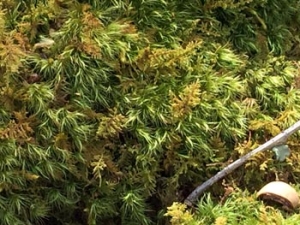
Close-up of moss showing its fernlike leaves
What is moss?
There are two basic types of plants, vascular and nonvascular. Mosses belong to the group of nonvascular plants known as bryophytes. That is, they do not have a vascular system for carrying fluids and nutrients. They also do not have true roots, stems, flowers or fruit. Their leaves are one cell thick, and they obtain water and nutrients through absorption of mist, dew, rain, snow and dust particles. Rather than roots, they have rhizoids, thin rootlike structures that hold the plants in place. Mosses can reproduce in several ways. They can reproduce sexually by spores and asexually by sending out shoots. The spore structures on mosses (often tiny capsules that sit on threadlike stems) can be very colorful. Mosses can also spread by fragmentation; small pieces may be broken off and carried by rain, wind or animals to another place.
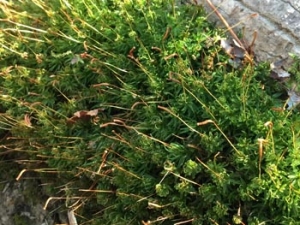
Close-up of moss showing its spore structures.
Bryophytes include mosses, liverworts, hornworts and algae. The leaves on mosses are usually pointed and grow in a spiral around the main stem; liverworts’ leaves are rounded and they do not spiral. While there are thousands of species of mosses and liverworts, there are far fewer species of hornworts, perhaps only a hundred, and it is rare to find them because they grow close to the ground in flat colonies.
There are about 10,000 species of moss, and it is very difficult to distinguish among them. Bryologists often use a microscope to determine the species. Below are four common mosses that are suggested for moss gardens on the website Moss Acres.
- Hypnum imponens
Commonly known as fern moss or sheet moss, this species is found throughout the world. It is low-growing moss that has a fernlike shape. It can tolerate foot traffic and partial sunlight. - Leucobryum glaucum
This moss is commonly known as pincushion, cushion or white moss as it has a mounding growth habit. It is a lighter green than many other species and can tolerate a range of habitats. - Polytrichum commune
This versatile and prolific moss is found growing throughout the world in a range of habitats, as it can tolerate shade to partial sun. It is commonly known as hair cap moss. - Dicranum scoparium
The common names for this moss are mood moss, windswept moss, broom moss, footstool moss and cushion moss. It has stiff leaves. This moss will grow in deep shade and on rocks and boulders.

A moss lawn in shades of green and gold
What conditions favor the growth of moss?
Most mosses grow in shady, damp or moist areas. They favor compacted, poorly drained soils that are high in acidity. They prefer a soil pH of 4.5 to 5.0. A soil pH of 5.5 is about the highest they tolerate, and they will grow in soil with a pH lower than 4.5. There are mosses that will grow in the sun, but most mosses prefer shady conditions.
What are the benefits of growing moss?
Growing moss is environmentally sound. Mosses do not require mowing, aerating, or the application of fertilizers, lime, herbicides or pesticides. They help with erosion control and improve the nutrient-holding capacity of soil. They also help break down rocks into soil, and they provide shelter for many small spiders and insects. They can be walked upon and are aesthetically pleasing.
How can you grow moss?
If you already have moss, you can encourage its growth by removing the grass around it. Moss is relatively easy to transplant; moss fragments can be scooped up with a spatula and firmly pressed or tapped down into a bare area of shady ground that has been cleared. The soil should be moist and compacted (not loose). Moss requires frequent misting, not soaking, until it becomes established.
I have a friend who carefully removes the moss growing on her roof and transplants it into her garden. Several books and websites talk about making a moss slurry (a moss milkshake) in your blender and spreading it on the ground, although moss expert Annie Martin says that this “widely promoted” method is “rarely successful.” You can also mail order moss fragments from several online moss distributors. In the wooded neighborhood where I live, several yards have become mostly moss over time. They are shades of green and gold even in the winter. A moss lawn provides a landscape that is easier to maintain than grass and is environmentally friendly and sustainable.
Reading about moss and observing it more closely has given me a whole new appreciation for this “lowly” plant. Complex in its growth habit, amazing in its variety, beautiful to look at, and soft to the touch, moss deserves a place of stature in the garden.
Resources
The Magical World of Moss Gardening, 2015, by Annie Martin
Moss Gardening: Including Lichens, Liverworts and Other Miniatures, 1997, by George Schenk
Moss Acres: The Enchanting Tranquility of a Moss Garden
Living with Mosses, Oregon State University
…updated 2021
